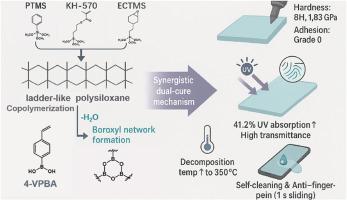Boroxy-modified UV dual-cure ladder-like polysiloxane coatings with excellent hardness, UV resistance
IF 4.5
2区 化学
Q2 POLYMER SCIENCE
引用次数: 0
Abstract
Protective hard coatings are crucial for the screens of electronic devices; however, conventional polymer coatings often face limitations in hardness, self-cleaning ability, and fingerprint resistance. In this study, we developed a novel UV dual-curable ladder-like polysilsesquioxane (LPSQ) coating, modified with boroxyl groups, to improve its protective performance. LPSQ was synthesized via a sol-gel process using controlled ratios of phenyltrimethoxysilane (PTMS), 3-methacryloxypropyltrimethoxysilane (KH-570), and 2-(3,4-epoxycyclohexyl)ethyltrimethoxysilane (ECTMS). The subsequent modification with 4-vinylphenylboronic acid (4-VPBA) introduced a boroxyl network through thermal dehydration. The resulting LPSQ-co-VPBA coating exhibited exceptional mechanical properties, achieving a pencil hardness of up to 8H and excellent adhesion (Grade 0). Notably, the LPSQ153-co-VPBA coating demonstrated extraordinary hardness of 1.83 GPa. Furthermore, the modified coating exhibited enhanced thermal stability, with its decomposition temperature rising from 200 °C to 350 °C, as well as superior UV shielding (41.2 % increase in absorption) and excellent visible light transmittance. Additionally, the coating displayed remarkable self-cleaning and anti-fingerprint properties, with artificial fingerprint liquid sliding off in just 1 s. These findings underscore the potential of boroxyl-modified LPSQ coatings as high-performance protective materials for next-generation electronic device screens. It offer superior hardness, optical clarity, thermal stability, and self-cleaning properties.


硼氧改性UV双固化阶梯状聚硅氧烷涂料具有优异的硬度,耐紫外线
保护性硬涂层对电子设备的屏幕至关重要;然而,传统的聚合物涂层在硬度、自洁能力和抗指纹等方面存在局限性。在这项研究中,我们开发了一种新型的紫外双固化梯状聚硅氧烷(LPSQ)涂层,用硼氧基改性,以提高其防护性能。以苯三甲氧基硅烷(PTMS)、3-甲基丙烯氧基丙基三甲氧基硅烷(KH-570)和2-(3,4-环氧环己基)乙基三甲氧基硅烷(ECTMS)为原料,采用溶胶-凝胶法制备了LPSQ。随后用4-乙烯基苯基硼酸(4-VPBA)进行改性,通过热脱水形成硼氧网络。得到的LPSQ-co-VPBA涂层表现出优异的机械性能,具有高达8H的铅笔硬度和优异的附着力(0级)。值得注意的是,LPSQ153-co-VPBA涂层的硬度达到了1.83 GPa。此外,改性后的涂层热稳定性增强,其分解温度从200℃上升到350℃,具有良好的紫外线屏蔽性能(吸收增加41.2%)和优异的可见光透过率。此外,该涂层具有显著的自清洁和防指纹性能,人工指纹液在一秒钟内就能滑落。这些发现强调了硼氧基改性LPSQ涂层作为下一代电子设备屏幕高性能保护材料的潜力。它提供优越的硬度,光学清晰度,热稳定性和自清洁性能。
本文章由计算机程序翻译,如有差异,请以英文原文为准。
求助全文
约1分钟内获得全文
求助全文
来源期刊

Polymer
化学-高分子科学
CiteScore
7.90
自引率
8.70%
发文量
959
审稿时长
32 days
期刊介绍:
Polymer is an interdisciplinary journal dedicated to publishing innovative and significant advances in Polymer Physics, Chemistry and Technology. We welcome submissions on polymer hybrids, nanocomposites, characterisation and self-assembly. Polymer also publishes work on the technological application of polymers in energy and optoelectronics.
The main scope is covered but not limited to the following core areas:
Polymer Materials
Nanocomposites and hybrid nanomaterials
Polymer blends, films, fibres, networks and porous materials
Physical Characterization
Characterisation, modelling and simulation* of molecular and materials properties in bulk, solution, and thin films
Polymer Engineering
Advanced multiscale processing methods
Polymer Synthesis, Modification and Self-assembly
Including designer polymer architectures, mechanisms and kinetics, and supramolecular polymerization
Technological Applications
Polymers for energy generation and storage
Polymer membranes for separation technology
Polymers for opto- and microelectronics.
 求助内容:
求助内容: 应助结果提醒方式:
应助结果提醒方式:


